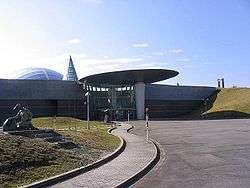Fukui Prefectural Dinosaur Museum
 | |
 Location within Fukui Prefecture  Fukui Prefectural Dinosaur Museum (Japan) | |
| Established | July 14, 2000 |
|---|---|
| Location | 51-11 Terao, Muroko-chō, Katsuyama, Fukui Prefecture, Japan |
| Coordinates | 36°04′58″N 136°30′24″E / 36.082909°N 136.506666°ECoordinates: 36°04′58″N 136°30′24″E / 36.082909°N 136.506666°E |
| Type | Natural history museum |
| Visitors | 901,119 (FY2016) |
| Architect | Kisho Kurokawa |
| Public transit access | Katsuyama Eiheiji Line (Echizen Railway) |
| Website | Official website |
The Fukui Prefectural Dinosaur Museum (福井県立恐竜博物館 Fukui Ken-ritsu Kyōryū Hakubutsukan), located in Katsuyama, Fukui, Japan, is one of the leading dinosaur museums in Asia that renowned for its exhibits of fossil specimens of dinosaurs and paleontological research.[1] It is sited near to the Lower Cretaceous strata of the Kitadani Formation of the Tetori Group, where a number of dinosaur fossils, including that of Fukuiraptor kitadaniensis and Fukuisaurus tetoriensis as well as of various aquatic life and land plants, are found and excavated.[2]
In October 2009, the whole area of Katsuyama City was recognized by the Japanese Geopark Committee as a Japanese Geopark under the name of "Dinosaur Valley Fukui Katsuyama Geopark."[3] Dozens of fossil specimens of dinosaurs at the museum and their excavation site have been designated as a Natural Monument of Japan since February 2017.[4] From July 2014, visitors can see the quarry in the Museum's field station, only with reservation required.[5]
The Asia Dinosaur Association Secretary Office has been housed inside the museum since its establishment in 2013.[6]
Exhibits
When visitors enter into the museum, they first see videos of local music heroes the Fukui Boys, who took the world by storm during their premiere performance at the Fukui International Activities Plaza. They then take a long escalator down to the first floor of the basement. The basement only contains "Dino Street," a hallway displaying fossils of some of the earliest known life on Earth. A bone bed sits at the end of the hallway and is a replica of an actual site in Wyoming, USA.
From there, visitors can go up to the main exhibition hall, which is the museum's primary exhibition space and consists of dinosaur fossils. Though many of the dinosaur fossils are replicas, some displays use actual dinosaur fossils and visitors are allowed to touch some of the displays. Various dioramas,[7] including some with robotic dinosaurs that move and make sounds, also are used to show visitors a conceptual look at the dinosaurs' habitats.
The second floor contains exhibits focusing on earth sciences, including plate tectonics, rock formation and precious gems. The third floor focuses on the history of life, showing a timeline from the formation of the Earth up until modern times. In addition to the dinosaurs, this exhibit shows some of the earliest single-celled organisms and their evolution into the mammals of today.
The museum also contains a "Dino Lab," which has real fossils on display that visitors can feel and lift up. There is also a fossil cleaning room where visitors can watch actual fossils being cleaned and preserved.
There are also outdoor exhibits to complement the main ones inside the museum. From the spring to the fall, visitors can experience excavation activities at a location on the park grounds. Additional replicas of dinosaurs and their fossils can be found throughout the park grounds.
Construction
The location for the museum was chosen because many fossils have been found in Katsuyama and it uses many fossils found in the surrounding area. The museum was designed by Kisho Kurokawa[8] and completed in the summer of 2000, as the centerpiece of the Dino Expo Fukui 2000 that was hosted in the nearby Nagaoyama Park.
It officially opened on July 14, 2000, with an area of approximately 30,000 m2 (320,000 sq ft), making it one of the largest museums in all of Japan. There are no support beams within the main display area of the building, allowing for wide open spaces to display the large dinosaurs.[7]
Sister museums
The Fukui Prefectural Dinosaur Museum signed a sister museum agreement with the following museums:[9]









See also
References
- ↑ Kato, Akira (2014-01-14). "CGI, scientific studies bring dinosaurs closer". The Japan Times. Retrieved 2018-07-26.
- ↑ Goto, Michiharu (2010). "Lower Cretaceous Planorbidae (Gastropoda) from the Kitadani Formation of the Tetori Group in Katsuyama City, Fukui Prefecture, Central Japan" (PDF). Memoir of the Fukui Prefectural Dinosaur Museum. Fukui Prefectural Dinosaur Museum (9): 41–45. Retrieved 2018-07-29.
- ↑ "Dinosaur Valley Fukui Katsuyama Geopark". Dinosaur Valley Fukui Katsuyama Geopark Promotion Council. Retrieved 2018-07-26.
- ↑ "国天然記念物の文化財指定について". Fukui Prefectural Dinosaur Museum. Retrieved 2018-07-26.
- ↑ "Field Station". Fukui Prefectural Dinosaur Museum. Retrieved 2018-07-29.
- ↑ "Asia Dinosaur Association". Retrieved 2018-07-29.
- 1 2 "Fukui Prefectural Dinosaur Museum". Chubu Wide-area Tourism Portal Site. 2008. Archived from the original on 2009-03-25. Retrieved July 10, 2008.
- ↑ Fukui Prefectural Dinosaur Museum: Kisho Kurokawa Architect and Associates. Edizioni Press. Accessed July 10, 2008.
- ↑ "FPDM:恐竜博物館との提携機関". Fukui Prefectural Dinosaur Museum. Retrieved 2018-07-29.
External links
| Wikimedia Commons has media related to Fukui Prefectural Dinosaur Museum. |